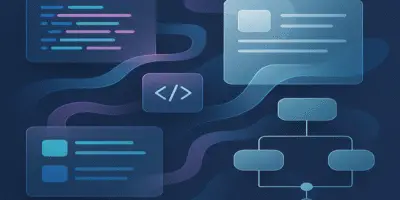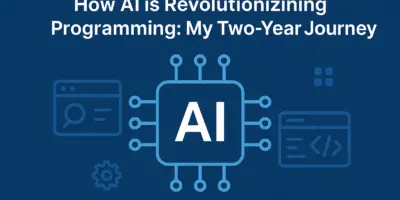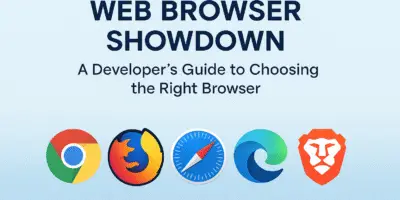Ever wonder why learning to code feels like you’re riding an emotional rollercoaster? One day you’re on top of the world, feeling like you could hack NASA with a few keystrokes, and the next day you’re staring at your screen wondering if you’re even cut out for this. Trust me, it’s worth it!
I’ve been there. We’ve all been there. That’s why today I want to walk you through the emotional stages every programmer experiences when learning to code. It doesn’t matter if programming is your first rodeo or you’re learning your tenth language—these psychological phases are as predictable as syntax errors in your first “Hello World” program.
Table of Contents
Stage 1: The Detective Phase (Research & Investigation)
This is where it all begins. You’ve heard programming is a great career path with solid prospects, so you decide to jump in. Suddenly, your entire timeline transforms into programming courses, ads for educational platforms, and groups full of people discussing code.
You start following content creators who talk about programming, but here’s the kicker—they all have different opinions! Then comes that million-dollar question: “What’s the best resource to learn from?”
You find yourself endlessly comparing Course A to Course B, or debating whether to learn Python or JavaScript first. Instead of actually learning, you’re stuck in an infinite loop of research and comparison.
How to Navigate This Stage:
First off, let’s get something straight—there’s no such thing as the “perfect resource.” Books, courses, and videos are just tools to help you learn. What works for someone else might not work for you.
What’s more important than finding the perfect resource is simply starting. Pick ONE trusted source and stick with it. If you’re into academic, in-depth explanations, try something like CS50. If you prefer simple, quick tutorials, check out free YouTube courses. If you want mentorship and someone to answer your questions, consider a paid course.
The key is to commit to your chosen resource and avoid juggling multiple sources that might confuse you. Set yourself a time limit for research—give yourself 24 hours to pick a resource, then start learning immediately. Don’t let the research phase drag on for weeks. Every day that passes without actual learning is a day wasted.
Stage 2: The Honeymoon Phase
Ah, the sweet beginning! Once you actually start learning to code, everything feels magical. Every new concept is exciting, and each bit of information you grasp feels like a major achievement.
Your motivation is at its peak during this stage. You eagerly open your course or book with intense enthusiasm, spending hours learning and proudly showing off your first program (which is probably just “Hello World”).
You feel like you’ve finally found your passion and that you’ll power through until you become a world-class programmer. Unfortunately, this stage is usually pretty short-lived.
How to Handle It:
The crucial thing to understand is that enthusiasm isn’t permanent—it’s just the initial push. What will actually keep you going is discipline and habit-building.
Use this honeymoon phase to establish a consistent learning schedule that you’ll stick to regardless of how you feel. Instead of studying only when you’re motivated, create a daily commitment—even if it’s just 30 minutes.
The goal is to build a routine rather than relying solely on your emotional state. It’ll feel awkward at first, but you’ll get there, even if it seems tough right now.
Another key point: don’t rush and assume you’re an expert just because you understand some basics. Many people in this phase feel they understand everything, leading to what’s called the “illusion of knowledge,” which we’ll talk about next.
In short, the programming honeymoon phase is like starting at the gym—it begins with enthusiasm, but consistency requires commitment and a patient mindset.
Stage 3: The Illusion of Knowledge
After riding the wave of enthusiasm, something interesting happens. As you keep moving through your course or learning resource, you start to feel like you’ve got it all figured out.
Suddenly, you’re blazing through lessons, solving exercises with ease, and feeling pretty confident in your abilities. That’s when you fall into a psychological trap known as the Dunning-Kruger effect.
This is a phenomenon where beginners tend to overestimate their knowledge because they don’t yet have enough experience to recognize how much they don’t know. Your brain tricks you into thinking you understand everything because you can’t yet grasp the depth of details you still haven’t learned.
In this stage, you might start skimming through important concepts, thinking, “I already get this, no need to focus too much.” You might even abandon your course to tackle complex projects before you’re ready. But reality hits when you try to build something from scratch—suddenly you’re lost, not knowing where to begin.
That’s when your inflated confidence takes a hit, and instead of feeling like an expert, you start feeling like you don’t understand anything at all. This leads directly to the next stage: doubt and frustration.
How to Deal With It:
First, be aware that this illusion of knowledge is completely normal—everyone experiences it. The Dunning-Kruger effect shows that beginners often have excessive confidence, but as they progress in learning, they start to realize how much they still don’t know, temporarily lowering their confidence before it rises again with genuine expertise.
To make sure you truly understand concepts, step outside your comfort zone with simple projects that test your knowledge. Try explaining what you’ve learned to someone else—this is one of the strongest ways to reveal whether your understanding is real or just a false sense of knowledge.
Get in the habit of asking yourself: “Do I really understand this, or have I just memorized it?” If you can’t explain it in simple terms to anyone, you probably haven’t fully grasped it yet.
Don’t rush through topics. Take your time and be thorough—rushing will only set you up for failure down the road.
Stage 4: The Valley of Despair (Doubt & Frustration)
After flying high on enthusiasm and surviving the false confidence phase, you hit the wall. This is where most people feel like they just can’t continue.
Suddenly everything becomes difficult. The questions you used to solve easily now seem complex and confusing. You find yourself unable to write code from memory. Every time you try to work on a project, you feel lost and don’t know where to start.
This is when negative thoughts take over: “I’m not smart enough for programming,” or “Other people learn faster than me,” or “I tried, but it’s no use—programming isn’t for me.”
The real problem here is that your mind starts convincing you that you’ll never succeed, which can make you give up on programming altogether. But the truth is, this is just a natural transition phase that everyone who continues in the field has gone through—including me!
How to Push Through:
First, understand that this frustration is normal. Everyone who has ever started programming has gone through this phase. Your mind is trying to trick you into thinking you’re a failure, but that’s not true.
The problem isn’t you—it’s that you’ve hit your first real challenge, and you’re not used to this feeling. You’re accustomed to things being easy, but real learning happens at the edge of your comfort zone.
Second, accept that you’ll fail more than you’ll succeed. Programming is about problem-solving, which means that failure or the inability to solve problems is an essential part of the journey. Every mistake teaches you something new. Don’t expect to be great without making plenty of mistakes first—failure isn’t the opposite of success; it’s part of it.
Third, change your learning approach if you’re stuck. If you’re not understanding concepts, try different methods. If you’ve been learning from videos, try reading articles or books. Or try learning through practical projects instead of just following courses. Change your learning pattern to renew your relationship with programming.
Most importantly, don’t compare yourself to others. Everyone learns at their own pace. The person you see learning quickly might have been trying for years without you knowing. Compare yourself to who you were a week or a month ago, not to someone else.
If you feel overwhelmed, take a short break—a day or two—but don’t push yourself too hard. However, don’t disconnect completely because coming back will be even harder.
Remember why you started in the first place. Go back to day one when you decided to learn programming and ask yourself: What was my goal? Why was I so excited? Am I ready to give up and throw away everything I’ve done?
Write this down and keep it where you can see it. Whenever you feel discouraged, read it thoughtfully—really feel what you’ve written, don’t just skim it.
This is probably the toughest stage, and everyone learning to code goes through it. What matters is knowing how to handle it and getting through it with minimal damage.
Stage 5: Stability & Persistence
After surviving the despair phase, you finally start to feel like you’re getting it. You begin to understand things more clearly. You might not be a genius, but at least you’ve grasped some fundamentals well.
Things that used to confuse you now seem easier. You’ve become more comfortable with code and have abandoned the idea that you need to memorize everything. Instead, you know how to search for solutions and understand them on your own. You feel like you’ve matured and can see where things are heading.
But this stage isn’t all sunshine and rainbows either. You’ll still encounter difficult concepts. Sometimes you’ll feel like you’re learning or progressing slowly, even though you’re on the right track. There might be periods when you feel stuck in the same place with no progress, but in reality, you’re gaining experience.
How to Make the Most of It:
First, develop your skills with real projects. If you haven’t built complete projects yet, this is the perfect time to start. Choose something specific to work on, create smaller versions of it, and apply the knowledge you’ve gained from all those courses to your project.
Next, start exploring more advanced topics gradually. You’ve got the basics down, so now you can look at concepts like algorithms, data structures, OOP, and other meaty subjects that require focus.
Learn how to search for information effectively. Programming has nothing to do with memorization—a significant part of programming is knowing how to find solutions when you need them. Stack Overflow, MDN, and even ChatGPT are all valuable resources. Learn how to navigate through documentation for programming languages and libraries you use, and if possible, learn how to use AI tools like ChatGPT to get the answers you need and help you in your learning journey.
Final Thoughts
The learning journey in programming isn’t a straight line—it’s a path with ups and downs, enthusiasm and frustration, doubt and confidence. The fundamental difference between those who continue and those who give up is that those who continue understand that this is normal and approach each stage with awareness and patience.
Honestly, the secret isn’t talent at all—it’s persistence. The most successful people I’ve known in my life are those who kept going, not those with extraordinary abilities or intelligence. Without persistence, intelligence is worthless.
If you’ve hit the frustration phase that everyone falls into, remember you’re not alone. Anyone you see as successful has gone through the same phase before you. Take things step by step, don’t rush, and always remember that a programmer isn’t someone who has all the answers in their pocket—a programmer is someone with the ability to search, learn, and continuously improve.
So, where are you in your programming journey right now? What challenges are you facing? I’d love to hear about your experiences in the comments below!



